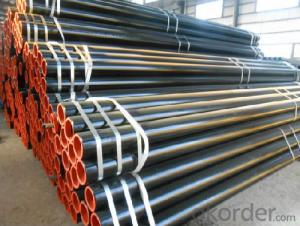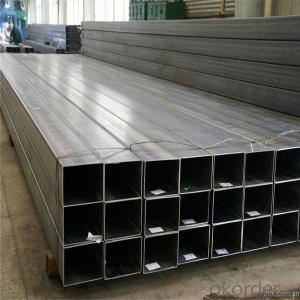Stainless Steel Rectangular Pipe ASTM A554 304 316 201 Made in China
- Loading Port:
- China Main Port
- Payment Terms:
- TT or LC
- Min Order Qty:
- 30 m.t.
- Supply Capability:
- 12000 m.t./month
OKorder Service Pledge
OKorder Financial Service
You Might Also Like
1、Structure of Seamless Pipe ASTM A106/53:
Seamless pipe is formed by drawing a solid billet over a piercing rod to create the hollow shell. As the manufacturing process does not include any welding, seamless pipes are perceived to be stronger and more reliable. Historically seamless pipe was regarded as withstanding pressure better than other types, and was often more easily available than welded pipe.
Application
Decorations, constructions Oil and chemical industry Food industry and pharmaceutical industry Rustless, stainless, good corrosion resistance, anti-wearing, good Water transportation systems
2、Main Features of the Seamless Pipe ASTM A106/53:
• High manufacturing accuracy
• High strength
• Small inertia resistance
• Strong heat dissipation ability
• Good visual effect
• Reasonable price
3、Seamless Pipe ASTM A106/53 Specification:
Standard | GB, DIN, ASTM ASTM A106-2006, ASTM A53-2007 |
Grade | 10#-45#, 16Mn 10#, 20#, 45#, 16Mn |
Thickness | 8 - 33 mm |
Section Shape | Round |
Outer Diameter | 133 - 219 mm |
Place of Origin | Shandong, China (Mainland) |
Secondary Or Not | Non-secondary |
Application | Hydraulic Pipe |
Technique | Cold Drawn |
Certification | API |
Surface Treatment | factory state or painted black |
Special Pipe | API Pipe |
Alloy Or Not | Non-alloy |
Length | 5-12M |
Outer Diameter | 21.3-610mm |
Grade | 20#, 45#, Q345, API J55, API K55, API L80, API N80, API P110, A53B |
Standard | ASME, ASTM |
1.ASTM A554, Q/GBS1-2005, customers' requests available
2.10*10mm,12*12mm,18*18mm,23*23mm,38*38mm,50*50mm,
3.70*70mm,100*100mm,20*10mm,23*11mm,24*12mm
4. 25*13mm,36*23mm,40*20mm,50*20mm,60*15mm,75*45mm
5.Cold drawn, Annealed with nitrogen protection, Ultrasonic welding,
4、Packaging & Delivery
Packaging Details: | seaworthy package,bundles wrapped with strong steel strip |
Delivery Detail: | 15-30days after received 30%TT |
5、FAQ of Seamless Pipe ASTM A106/53:
①How is the quality of your products?
Our products are manufactured strictly according to national and internaional standard, and we take a test
on every pipe before delivered out. If you want see our quality certifications and all kinds of testing report, please just ask us for it.
Guaranteed: If products’ quality don’t accord to discription as we give or the promise before you place order, we promise 100% refund.
②How about price?
Yes, we are factory and be able to give you lowest price below market one, and we have a policy that “ for saving time and absolutely honest business attitude, we quote as lowest as possible for any customer, and discount can be given according to quantity”,if you like bargain and factory price is not low enough as you think, just don’t waste your time.Please trust the quotation we would give you, it is professional one.
③Why should you chose us?
Chose happens because of quality, then price, We can give you both.Additionally, we can also offer professional products inquiry, products knowledge train(for agents), smooth goods delivery, exellent customer solution proposals.Our service formula: good quality+good price+good service=customer’s trust
SGS test is available, customer inspection before shipping is welcome, third party inspection is no problem.
6、Seamless Pipe ASTM A106/53 Images:


- Q: Can stainless steel pipes be used for exhaust systems?
- Indeed, exhaust systems can utilize stainless steel pipes. Stainless steel, renowned for its exceptional resistance to both corrosion and heat, is a favored material for exhaust systems. It possesses the ability to withstand the severe temperatures and harsh circumstances to which exhaust systems are exposed, rendering it an enduring and long-lasting alternative. An added benefit of stainless steel pipes is their lightweight nature, which can enhance the performance of the exhaust system. Furthermore, stainless steel pipes can be effortlessly manipulated and molded, allowing for tailor-made adaptations to suit various vehicle models and configurations. All in all, stainless steel pipes present a dependable choice for exhaust systems, guaranteeing outstanding performance and longevity.
- Q: How thick is the 3 stainless steel tube?
- Refers to the stainless steel tube with a wall thickness of 3 mm.
- Q: Can stainless steel pipes be used for construction purposes?
- Indeed, construction purposes can certainly make use of stainless steel pipes. This material, known for its exceptional durability and resistance to corrosion, proves itself suitable for a wide range of construction applications. It finds common employment in structural projects, providing dependable support for building frameworks, handrails, and support structures. Moreover, stainless steel pipes serve vital roles in plumbing systems, drainage systems, and HVAC systems. Notably, they often take precedence in construction endeavors that prioritize hygiene and cleanliness, such as hospitals, food processing plants, and laboratories. In summary, stainless steel pipes deliver exceptional strength, longevity, and resistance to rust and corrosion, rendering them an unwavering choice for construction endeavors.
- Q: Are stainless steel pipes suitable for pharmaceutical factories?
- Stainless steel pipes are indeed appropriate for pharmaceutical factories. The pharmaceutical industry favors stainless steel due to its exceptional resistance to corrosion and its hygienic properties. It can withstand high temperatures, pressures, and various chemicals, making it perfect for the transportation and storage of pharmaceutical products, chemicals, and other fluids. Additionally, stainless steel pipes possess a smooth surface that facilitates effortless cleaning and prevents the accumulation of bacteria, guaranteeing the purity of pharmaceutical products. Moreover, stainless steel is a long-lasting and durable material, reducing the need for frequent replacements and maintenance. In conclusion, stainless steel pipes are a dependable and appropriate choice for use in pharmaceutical factories.
- Q: Can stainless steel pipes be used for structural purposes?
- Yes, stainless steel pipes can be used for structural purposes. Stainless steel is known for its strength, durability, and resistance to corrosion, making it an excellent material for structural applications. Stainless steel pipes are commonly used in various industries such as construction, architecture, and engineering for structural support, as well as for conveying fluids and gases. They can withstand heavy loads, extreme temperatures, and harsh environmental conditions, making them suitable for a wide range of structural applications. Additionally, stainless steel pipes are available in different grades, sizes, and thicknesses, allowing for customization to meet specific structural requirements.
- Q: Can stainless steel pipes be used for breweries?
- Yes, stainless steel pipes are commonly used in breweries. Stainless steel is the preferred material for brewing equipment and piping systems due to its excellent corrosion resistance, durability, and hygienic properties. Stainless steel pipes can withstand the harsh and acidic conditions present in breweries, such as high temperatures, alkaline and acidic cleaning agents, and exposure to various chemicals. Additionally, stainless steel pipes are easy to clean and maintain, ensuring that the beer produced remains uncontaminated and of high quality. Overall, the use of stainless steel pipes in breweries helps to ensure a safe and efficient brewing process.
- Q: Are stainless steel pipes suitable for food processing plants?
- Yes, stainless steel pipes are highly suitable for food processing plants. Stainless steel is a commonly used material in the food industry due to its numerous beneficial properties. Firstly, stainless steel pipes are resistant to corrosion, which is crucial in an environment where food products are processed. Corrosion can contaminate food and compromise its safety, but stainless steel pipes are resistant to rust and other forms of corrosion, ensuring the integrity of the food being processed. Secondly, stainless steel pipes are easy to clean and maintain. The smooth surface of stainless steel pipes prevents the accumulation of food particles and bacteria, making them hygienic and easy to sanitize. This is particularly important in food processing plants where cleanliness and food safety are of utmost importance. Additionally, stainless steel is a non-reactive material, meaning it does not leach any harmful substances into the food being processed. This ensures that the quality and taste of the food are not affected by the piping material. Furthermore, stainless steel pipes have excellent heat resistance, allowing them to withstand high temperatures without warping or deforming. This makes them suitable for various food processing operations that involve heat, such as pasteurization or sterilization. In summary, stainless steel pipes are highly suitable for food processing plants due to their corrosion resistance, ease of cleaning, non-reactivity, and heat resistance. They contribute to maintaining the safety, hygiene, and quality standards required in the food industry.
- Q: What's the difference between stainless steel decorative pipes and polished stainless steel pipes?
- Stainless steel decorative tubes are mainly used for decoration, such as railings, staircases, hand guards, railings, windows and so on, the wall thickness is very thin,Polished stainless steel pipe is not the same, the industry can also be used, that is, just made out, some rough, not smooth, so polished under the smooth, according to customer needs.
- Q: Can stainless steel pipes be used for solar energy systems?
- Yes, stainless steel pipes can be used for solar energy systems. Stainless steel is a versatile and durable material that can withstand the harsh conditions of solar energy systems. It is resistant to corrosion, which is crucial for the longevity of the pipes in outdoor and exposed environments. Stainless steel pipes also have excellent heat resistance properties, making them suitable for transporting hot fluids within solar energy systems. Additionally, stainless steel has a high strength-to-weight ratio, making it ideal for supporting the weight of solar panels or other components in the system. Overall, stainless steel pipes are a reliable and efficient choice for solar energy systems.
- Q: Can stainless steel pipes be insulated with mineral wool?
- Yes, stainless steel pipes can indeed be insulated with mineral wool. Mineral wool is a common and effective insulation material used in various industries, including plumbing and construction. It is capable of withstanding high temperatures and offers excellent thermal and acoustic insulation properties. Additionally, mineral wool is non-combustible and resistant to moisture, making it suitable for insulating stainless steel pipes that carry hot or cold fluids. The insulation can help prevent heat loss, reduce energy consumption, and protect against condensation and pipe sweating.
Send your message to us
Stainless Steel Rectangular Pipe ASTM A554 304 316 201 Made in China
- Loading Port:
- China Main Port
- Payment Terms:
- TT or LC
- Min Order Qty:
- 30 m.t.
- Supply Capability:
- 12000 m.t./month
OKorder Service Pledge
OKorder Financial Service
Similar products
Hot products
Hot Searches
Related keywords


























